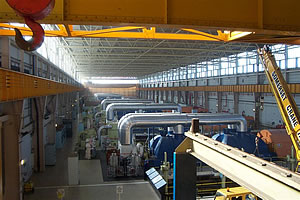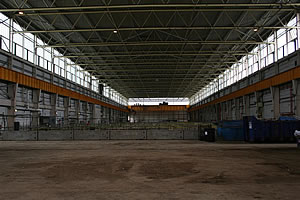Decommissioning of Hinkley A - End of an Era
September 2007

Dismantling the turbines
For decades its six giant turbines produced enough power to meet the needs of a city the size of Bristol and when built in 1960 it was the largest single span building of its kind in Europe.
Now its an empty shell – as deep as it is high – and roughly the size of two soccer pitches end-on-end. The turbine hall at Hinkley Point A decommissioning site was once somewhere you could not go without ear protectors and the whole place seemed to vibrate as the steam-driven rotors spun at 3000 rpm. In the basement the building was a maze of pipes, condensers to return the steam to water – and electrical equipment.

Hinkley A Turbine Hall
So how do you decommission such a building – “very carefully and of course, safely” according to Steve Jackson, who along with Ian Walker was one of the two Magnox project engineers entrusted with the job. Magnox is currently decommissioning the site on behalf of the owners, the Nuclear Decommissioning Authority (NDA).
First to go in the turbine hall was the man made mineral fibre (MMMF) and asbestos lagging removed by specialist contractors Kitsons under strict conditions and taken to authorised sites for disposal. At the time it was the largest contract of its type in Europe as 61,080 kgs of MMMF and 328,480 kgs of asbestos were taken away in more than 100 skips.
Some 257 miles of scaffolding weighing 614 tonnes and held together by 42,000 fittings was needed. Hundreds of gallons of oil were safely drained from the huge systems put in barrels and disposed of at approved sites. Dozens of electrical systems had to be checked and made safe with nearly 30 tonnes of copper cable ends recovered and recycled.

But it was the machinery itself that probably gives the most impressive statistics. Around 11,000 tonnes of scrap metal was recovered to be recycled – in itself generating tens of thousands of pounds of income to help pay for the decommissioning. That’s enough metal to build 40 Airbus A380s. It was taken by lorry to dealers in Wales, Birmingham and Teeside. On one day alone 400 tonnes left site and the project ensured local stakeholders were consulted to ensure the timings of such convoys caused the least possible disturbance. Some of the equipment was removed in one piece – one of the huge turbines weighing around 128 tonnes was shipped to a company so their apprentices could train on it. At the other end of the scale a specialist firm recovered 65 kgs of mercury from 356 tilt switches, temperature gauges etc out of 2,888 that were surveyed for the metal.

Deplanting of the hall was carried out in zones by contractors Brown and Mason. Two large overhead gantry cranes installed when the turbine hall was constructed were refurbished for the job. A lot of the metal had to be hot cut into smaller pieces for removal and again this was carried out under stringent conditions with access to the building strictly controlled.
Steve Jackson said:
“There was background monitoring within the building for fumes produced by cutting the metal and workers themselves were regularly checked. There was no radioactivity within the building or plant as this was conventional plant that you would find in any gas, oil or coal power station. We monitored safety measures within the turbine hall throughout the contract and reinforced them with some of our own site standards.”
A lot of the metal was expected to find its way to China with the copper going to be used in building a non-nuclear power station there. Two large turbine shafts made of extremely high quality metal were shipped to Japan for recycling. Steve said:
“It was a testament to the engineering of Hinkley Point A which was built in the late fifties and early sixties, that the majority of this plant dates back to when it was built - more than 45 year’s ago.”
The project was completed on time and to budget with the empty hall due to be demolished later in the site’s decommissioning programme. Hinkley Point Site Stakeholder Chair Michael Short had a tour of the empty building and said:
“This was an impressive project which was completed in a safe and efficient manner with a considerable amount of the material being recycled to help meet the decommissioning costs.”
Hinkley Point began generating in 1965 and was officially closed in 2000. During its operation the station had produced enough electricity to supply the whole of the UK’s domestic needs for more than 12 months. Using coal to generate the same amount of electricity during that period would have resulted in emissions of approximately 100 million tonnes of the greenhouse gas, carbon dioxide.
In January 1989, the station set a new world record for continuous generation of 700 days, seven hours and 12 minutes. In 1997, Hinkley became the first Magnox station to generate 100 TWh – enough power to run 100 billion 1kw electric fires.

